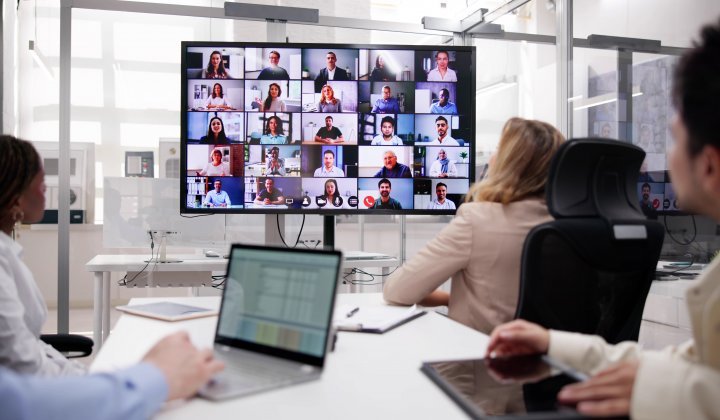If you’re over the age of 30 and enter the TikTok app for the first time, you’ll be wondering which parallel universe you’ve just stumbled into. You’ll also wonder what the fuss is all about.
TikTok is a short-form video app that allows you to post 15-second videos of yourself. You can stitch four consecutive videos together giving you a maximum of 60 seconds to make a fool of yourself. And therein lies the key.
It throws you in at the deep end and just feeds you videos...
TikTok is meant to be a self-deprecating environment – the sillier and goofier your videos are, the better. For its mostly teen fans (41% of TikTok users are aged between 16 and 24) it is a welcome alternative to other social media platforms. Twitter has too many trolls, Facebook is for parents, LinkedIn is too corporate, and Instagram is too focused on perfection and self-promotion.
Music clips to lip-sync or dance to, as well as “challenges” to recreate a popular dance move, are what drives the app’s popularity, as are the arsenal of special effects that go way beyond mere filters. There are enough augmented reality overlays, green screens and graphics to certify any user as a video editor. So, don’t be surprised to find someone swimming through a bowl of porridge, replicating multiple clones of themselves, jiving to Jerusalema, going through numerous wardrobe changes (with flawless editing), a rabbit hole of cat videos, and even a video involving an egg, Vaseline, a balloon, toothpaste, soap and vinegar – don’t ask.
TikTok is addictive and like all social media apps is designed to keep you scrolling (known as “eyeball time”), but there is a crucial difference, and it’s all down to its unique algorithm. Unlike other social media platforms, TikTok doesn’t ask you to find your friends or make you create a digital persona. It throws you in at the deep end and just feeds you videos, tracking which ones you watch and then deciphering what your preferences are. Once it figures that out, it has you hooked. The average time most users stay on the app is 52 mins per day. That’s a lot of silly 15-second videos but an impressive engagement commitment, which is, of course, a lure for brands and the booming industry of influencer marketing.
TikTok’s history and numbers
In 2014, a new social media app called Musical.ly started to gain traction with teenagers. It was similar to what TikTok is today: user-generated videos that were blended with popular songs. By 2017, the app had over 200 million users.
In 2016, the Chinese app developer company, ByteDance, launched a rival app called Douyin in China. It was rebranded to TikTok to grow an international market. Within a year it had 100 million sign-ups. In 2017, ByteDance acquired Muiscal.ly for US$800 million and merged both apps under TikTok, although TikTok is still called Douyin in China.
TikTok is currently available in 155 countries and in 75 languages. It has been downloaded over two billion times and has 800 million active users worldwide. 40% of TikTok users are located outside China and it has been downloaded over 600 million times in India, while in America there are “only” 45.4 million users, but in less than 18 months the number of users grew 5.5 times, and the numbers continue to climb.
Approximately 100 million videos are viewed daily.
TikTok houses: Social media fraternities and sororities
With these eyewatering numbers it was just a matter of time before brands would come calling in search of social media influencers, and numbers of followers for the top TikTok accounts are just as gobsmacking.
For example, South Africa’s reigning king of TikTok is magician, Wian van den Berg, with 9.6 million followers and an average of 183.7 million likes collectively. However, the “ruling queen” of TikTok is Charli D’Amelio with (at the time of writing, it keeps climbing) 87.2 million followers and over 6.6 billion likes, collectively, for her videos. Most of her posts garner an average of 30 to 40 million likes. Charli, who is 16 years old, is an aspiring dancer.
Just as YouTube created studios specifically for their top performing stars, TikTok influencer houses quickly emerged. These houses serve as palatial dormitories where TikTok stars live, work on their content and hustle their accounts. The global epicentre for these influencer houses is in Los Angeles where the taste of Hollywood fame and fortune is tangible.
One of the more prominent TikTok houses is Hype House (there are many more: The Sway House, The Clubhouse, The Click House, The Drip Crib, The Valley House, The Kids Next Door, The Vibe House, The Alpha House – you get the idea). Hype House was formed in December 2019 for a group of TikTok’s most talked-about stars – Charli D’Amelio lives there – and was the brainchild of Chase Hudson (then 17 years old with 24.5 million followers) and Thomas Petrou (a 21-year-old YouTube star with 7.4 million TikTok followers).
Some members live full-time in the house with other members using it as a working base. The houses are leased and paid for by the TikTok stars and come with strict rules. Members can have friends over, but it’s not a party house. If someone breaks something, it must be replaced within 15 days (the houses are short-term rentals). And, most importantly, if you want to be a house member, you have to produce content daily. These TikTok houses are perceived to be party dens, but they are run as businesses.
When it launched, #hypehouse started trending immediately and to date the hashtag has amassed 4 billion views. Not too shabby for a bunch of adolescents armed with smartphones and TikTok as their social media weapon of choice. Why else would Rihanna create her own TikTok house, especially for her make-up brand Fenty Beauty?
...Tik Tok houses are perceived to be party dens, but they are run as businesses....
More than just a silly Gen Z app
It’s not only brands that have cottoned on to the power, and influence, of TikTok (when snack brand Kind launched their first campaign on TikTok, it received 18 million views in the first 24 hours). It has also revolutionised the music industry. It has fast become the hunting ground for new artists, as well as a platform that is reshaping how music is made and marketed. Artists like Billie Eilish, Selena Gomez and Lizzo have had their music go viral on TikTok, and even more established singers like Mariah Carey have found new audiences via the app.
The money is getting bigger, the stakes are getting higher, and the key players are getting younger. So much so that Triller, an app similar to TikTok which was launched in 2015, recently announced that they had hired Josh Richards – 18 years old with 21 million followers – as their new chief strategy officer and persuaded two other TikTok stars, Griffin Johnson (21) and Noah Beck (19) to become investors.
Instagram is now throwing money at key TikTok creators to create content for Reels, the platform’s new competitive offering, while YouTube also launched their TikTok derivative, Shorts. It seems we’re entering the golden age of short form video apps.
But apart from the app’s silly side, it is becoming a credible platform for social justice causes. Mental health issues are very prevalent with Gen Z and, unlike older generations, they are comfortable talking openly about their struggles and challenges.
Videos with the hashtag #CAMHS (child and adolescent mental health services) have garnered over 106.1 million views as young users share their experiences with anything from anorexia to depression. Doctors and mental health practitioners have subsequently also taken to TikTok to dispense advice. The BBC interviewed a fertility doctor, a psychiatrist and an immigration lawyer, all of whom are all using the app to help combat misinformation in their fields.
TikTok is to Black Lives Matter what Twitter was to the Arab Spring
Young Muslim women are using the platform to speak out about Islamophobia, while young LGBTQ+ people are sharing and discussing coming out to their parents. It was just a matter of time before these young social justice warriors would turn their attention to politics.
App activism
The killing of George Floyd by Minneapolis police officers in May, sparked worldwide protests, and it was clear that the age profile of the protesters, globally, was a younger one. Social media has always been an integral part of modern-day protest movements and in 2020, Tik Tok was added to the arsenal.
“TikTok is to Black Lives Matter what Twitter was to the Arab Spring,” said Kareem Rahma, in an interview with the New York Times, “I saw a lot of youth on the ground TikTok’ing the protests as opposed to livestreaming, tweeting or Instagramming,” he said. “The conversations these kids are having with each other are essential.”
President Trump found out just how crucial these conversations are a few weeks later when he travelled to his election rally in Tulsa, Oklahoma. An overflow area outside the 19,000-seat event arena was prepared for the crowds but only 6,000 supporters arrived.
Teenage TikTok users and Korean K-pop fans claimed responsibility. When Trump’s campaign team posted a tweet urging supporters to register for free tickets using their phones, K-pop fans began sharing the information with followers, encouraging them to register, but not show up. Trump’s campaign team deny the claim, but the voice of young people was being heard, as was the presence and influence of TikTok being felt.
Don’t mess with K-pop “stans”
It seemed an unlikely pairing or even a threat, but K-pop (a genre of Korean pop music that has become a global phenomenon) and their stans (overzealous or obsessive fans) have made their mark on political or social justice movements.
When anti-Black Lives Matter sentiment emerged on social media in the form of #whitelivesmatter, the stans simply flooded the hashtags with gifs and memes, so when those supporters searched for anti-Black Lives Matter content, they were met with a barrage of images and videos of popular K-pop groups. Even the Dallas police department’s call for information on #blm protesters was thwarted by K-pop fans.
Empowered and emboldened by both the global Black Lives Matter protests, as well as the sabotaging of Trump’s rally, TikTok users are quickly learning that this platform is so much more than a portal of benign videos and that influencers can do more than just promote a brand.
When Trump announced that he would ban the app in America, nine TikTok creators – with, collectively, 54 million followers – published an open letter to the President, urging him to find another solution. I doubt that their letter will influence the political cold war he has embarked on with China, but it would be foolhardy to simply brush these teenagers aside.
Many will be voting for the first time, and those who were ambivalent about voting could be spurred to do so in retaliation. Talks of banning the app have only served to politicise TikTok users further as they feel that Trump’s threats are a direct response to their campaigns against him. Eitan Bernath (18) – with 1.2 million followers – vocalised what many of his age are thinking: “For many kids, politics feel very distant,” he said, “This might be the first time it hits home for a lot of kids.”
The moral of the story? Don’t mess with or underestimate digital natives. They could just swing an election.
Dion Chang is the founder of Flux Trends.
For more trends, visit www.fluxtrends.com.





